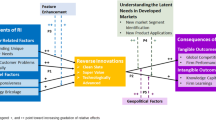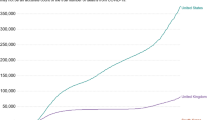Abstract
The locus of innovation in the global economy appears to be changing because of the rise of emerging economies, such as China and India, and the “flattening” of the world. Poor emerging markets no longer just borrow innovations from developed countries; from time to time they also contribute innovations to the rest of the world, including developed countries.2 We refer to this as reverse innovation, that is, the case where an innovation is adopted first in a poor country before being adopted in rich ones. Instances of reverse innovation still appear to be rare, and it is hard to tell if this will change materially in the future. Therefore, this chapter is about a nascent phenomenon whose future potential is uncertain. Nevertheless, reverse innovation is a promising area for research by international business and strategy scholars because it provides the opportunity to enrich and extend mainstream theories in a number of areas. At the same time it raises the level of awareness necessary for governments trying to foster innovation, the role facilitating institutions might play (NGOs, R&D labs around the world), and finally the potential benefits that multinational companies might gain to sustain a competitive advantage.
Access this chapter
Tax calculation will be finalised at checkout
Purchases are for personal use only
Preview
Unable to display preview. Download preview PDF.
Similar content being viewed by others
References
Ahuja, G. and Lampert, C. M. (2001). “Entrepreneurship in the Large Corporation: A Longitudinal Study of How Established Firms Create Breakthrough Innovations.” Strategic Management Journal, 22 (6–7): 521–43.
Ambos, B., Asakawa, K., and Ambos, T. (2010). “A Dynamic Perspective on Subsidiary Autonomy.” Paper presented at the Global Strategy Journal launch conference, Oak Brook, IL.
Amsden, A. (1992). Asia’s Next Giant: South Korea and Late Industrialization. New York: Oxford University Press.
Amsden, A. (2009). “Does Firm Ownership Matter? POEs vs. FOEs in the Develo** World.” In Ramamurti, R. and Singh, J. V. (eds) Emerging Multinationals in Emerging Markets. Cambridge, UK: Cambridge University Press, 64–77.
Balassa, B. and Noland, M. (1988). Japan in the World Economy. Washington, DC: Institute for International Economics.
Bartlett, C. A. and Ghoshal, S. (1989). Managing across Borders: The Transnational Solution. Boston, MA: Harvard Business School Press.
Cantwell, J. and Mudambi, R. (2005). “MNE Competence-Creating Subsidiary Mandates.” Strategic Management Journal, 26: 1109–28.
Caves, R. (2007). Economic Analysis and Multinational Enterprise. Cambridge, UK: Cambridge University Press.
Christensen, C. M. and Bower, J. L. (1996). “Customer Power, Strategic Investment, and the Failure of Leading Firms.” Strategic Management Journal, 17 (3): 197–218.
Cuervo-Cazurra, A. and Genc, M. (2008). “Transforming Disadvantages into Advantages: Develo**-Country MNEs in the Least Developed Countries.” Journal of International Business Studies, 39 (6): 957–79.
Friedman, T. (2005). The World Is Flat: A Brief History of the Twenty-first Century. New York: Farrar, Straus, and Giroux.
Ghemawat, P. (2001). “Distance Still Matters.” Harvard Business Review, 79 (8): 137–47.
Ghemawat, P. (2007). Redefining Global Strategy. Boston, MA: Harvard Business School Press.
Govindarajan, V. and Trimble, C. (2005a). “Building Breakthrough Businesses within Established Organizations.” Harvard Business Review, 83 (5): 58–68.
Govindarajan, V. and Trimble, C. (2005b). Ten Rules for Strategic Innovators: From Idea to Execution. Boston, MA: Harvard Business School Press.
Govindarajan, V. and Trimble, C. (2010). The Other Side of Innovation: Solving the Execution Challenge. Boston, MA: Harvard Business School Press.
Guillen, M. F. and Garcia-Canal, E. (2009). “The American Model of the Multinational Firm and the ‘New Multinationals’ from Emerging Markets.” Academy of Management Perspectives, 23 (2): 23–35.
Gupta, A. and Govindarajan, V. (2000). “Knowledge Flows within Multinational Organizations.” Strategic Management Journal, 21 (4): 473–96.
Hall, G. and Howell, S. (1985). “The Experience Curve from the Economist’s Perspective.” Strategic Management Journal, 6 (3): 197–212.
Immelt, J., Govindarajan, V., and Trimble, C. (2009). “How GE Is Disrupting Itself.” Harvard Business Review, 87 (10): 56–65.
International Monetary Fund (IMF). (2010). “World Economic Outlook Database.” IMF. Retrieved from http://www.imf.org/external/pubs/ft/weo/2010/02/weodata/index.aspx
Khanna, T. and Palepu, K. (2005). “Strategies that Fit Emerging Markets.” Harvard Business Review, 83 (6): 63–76.
Kuemmerle, W. (1997). “Building Effective Ramp;D Capabilities Abroad.” Harvard Business Review, 75 (2): 61–70.
Lessard, D. R. and Lucea, R. (2009). “Mexican Multinationals: Insights from CEMEX.” In Ramamurti, R. and Singh, J. V. (eds) Emerging Multinationals in Emerging Markets. Cambridge, UK: Cambridge University Press, 280–311.
Levinthal, D. A. and March, J. G. (1993). “The Myopia of Learning.” Strategic Management Journal, 14 (4): 95–112.
Madhok, A. (2010). “Acquisitions as Entrepreneurship: Inter-Nationalization and Emerging Market Multinationals.” Paper presented at Global Strategy Journal launch conference, Oak Brook, IL.
March, J. G. (1991). “Exploration and Exploitation in Organizational Learning.” Organization Science, 2 (1): 71–87.
Martinez-Jerez, F. A., Narayanan, V. G. and Jurgens, M. (2006). Strategic Outsourcing at Bharti Airtel. Boston, MA: Harvard Business School.
Nelson, R. R. (ed.). (1993). National Innovation Systems. Oxford: Oxford University Press.
O’Reilly, C. A. and Tushman, M. L. (2004). “The Ambidextrous Organization.” Harvard Business Review, 4 (4): 74–81.
Porter, M. E. (1990). The Competitive Advantage of Nations. New York: Free Press.
Prahalad, C. K. (2005). The Fortune at the Bottom of the Pyramid. Philadelphia, PA: Wharton School Publishing.
Prahalad, C. K. and Doz, Y. L. (1987). The Multinational Mission: Balancing Local Demands and Global Vision. New York: Free Press.
Ramamurti, R. (2009a). “What Have We Learned about Emerging-Market MNEs?” In Ramamurti, R. and Singh, J. V. (eds) Emerging Multinationals in Emerging Markets. Cambridge, UK: Cambridge University Press, 399–426.
Ramamurti, R. (2009b). “Impact of the Crisis on New FDI Players.” Paper presented at the Columbia University conference on FDI, the Global Crisis, and Sustainable Recovery. Columbia University, New York.
Ramamurti, R. and Singh, J. V. (eds). (2009a). Emerging Multinationals in Emerging Markets. Cambridge, UK: Cambridge University Press.
Ramamurti, R. and Singh, J. V. (2009b). “Indian Multinationals: Generic Internationalization Strategies.” In Ramamurti, R. and Singh, J. V. (eds) Emerging Multinationals in Emerging Markets. Cambridge, UK: Cambridge University Press, 110–66.
Rugman, A. (2009). “Theoretical Aspects of MNEs from Emerging Markets.” In Ramamurti, R. and Singh, J. V. (eds) Emerging Multinationals in Emerging Markets. Cambridge, UK: Cambridge University Press, 42–63.
The Economist. (2010). “New Masters of Management: Special Report on Innovation in Emerging Markets.” The Economist. Retrieved from http://www.economist.com/node/15894358
Tripsas, M. and Gavetti, G. (2000). “Capabilities, Cognition, and Inertia: Evidence from Digital Imaging.” Strategic Management Journal, 21 (10–11): 1147–61.
Tseng, N. H. (2010). “Behind China’s Surge in Patents.” Fortune. Retrieved from http://money.cnn.com/2010/10/14/news/international/china_patents_innovation.fortune/
Tsurumi, Y. (1976). The Japanese Are Coming: A Multinational Interaction of Firms and Politics. Cambridge, MA: Ballinger Publishing.
United Nations. (2005). Globalization of Ramp;D and Develo** Countries: Proceedings of an Expert Meeting. Geneva, Switzerland: United Nations.
Vernon, R. (1966). “International Investment and International Trade in the Product Cycle.” Quarterly Journal of Economics, 80 (2): 190–207.
Vernon, R. (1979). “The Product Cycle Hypothesis in a New International Environment.” Oxford Bulletin of Economics and Statistics, 41 (4): 255–67.
Von Hippel, E. (1986). “Lead Users: A Source of Novel Product Concepts.” Management Science, 32 (7): 791–805.
Williamson, P. and Zeng, M. (2009). “Chinese Multinationals: Emerging through New Gateways.” In Ramamurti, R. and Singh, J. V. (eds) Emerging Multinationals in Emerging Markets. Cambridge, UK: Cambridge University Press, 81–109.
Wilson, D. and Purushothaman, R. (2003). Dreaming with the BRICs: A Path to 2050. Global Economics Paper No. 99. New York: Goldman Sachs.
Yip, G. (1989). “Global Strategy… in a World of Nations?” Sloan Management Review, 31 (1): 29–41.
Editor information
Editors and Affiliations
Copyright information
© 2016 Vijay Govindarajan and Ravi Ramamurti
About this chapter
Cite this chapter
Govindarajan, V., Ramamurti, R. (2016). Reverse Innovation in Emerging Markets. In: Haar, J., Ernst, R. (eds) Innovation in Emerging Markets. International Political Economy Series. Palgrave Macmillan, London. https://doi.org/10.1057/9781137480293_8
Download citation
DOI: https://doi.org/10.1057/9781137480293_8
Publisher Name: Palgrave Macmillan, London
Print ISBN: 978-1-349-69390-0
Online ISBN: 978-1-137-48029-3
eBook Packages: Political Science and International StudiesPolitical Science and International Studies (R0)




